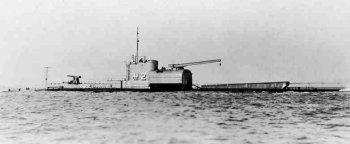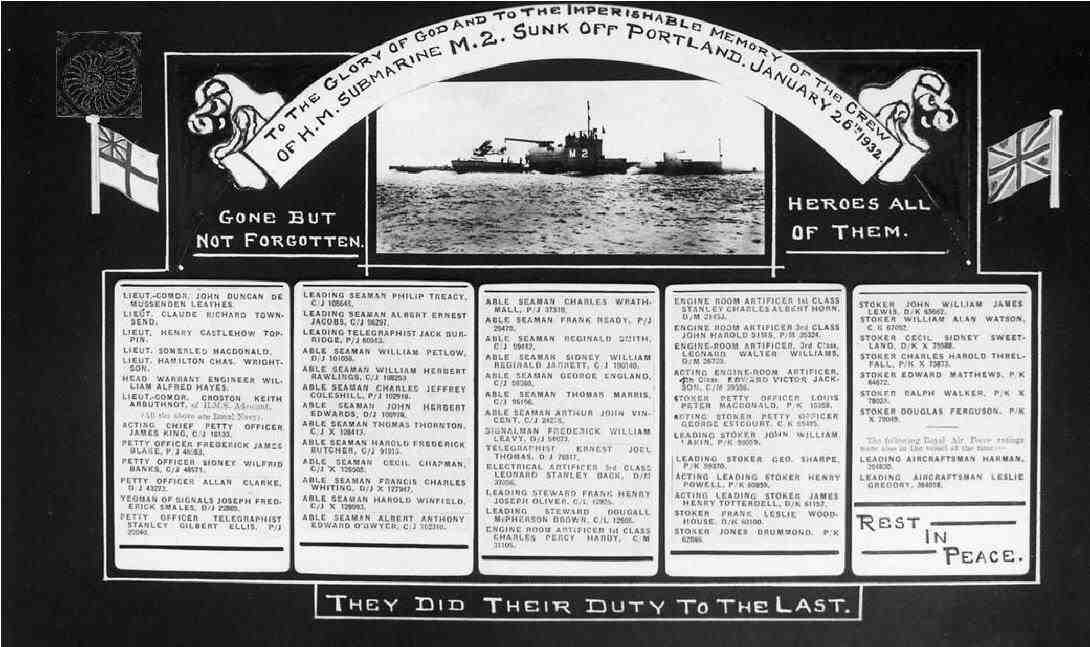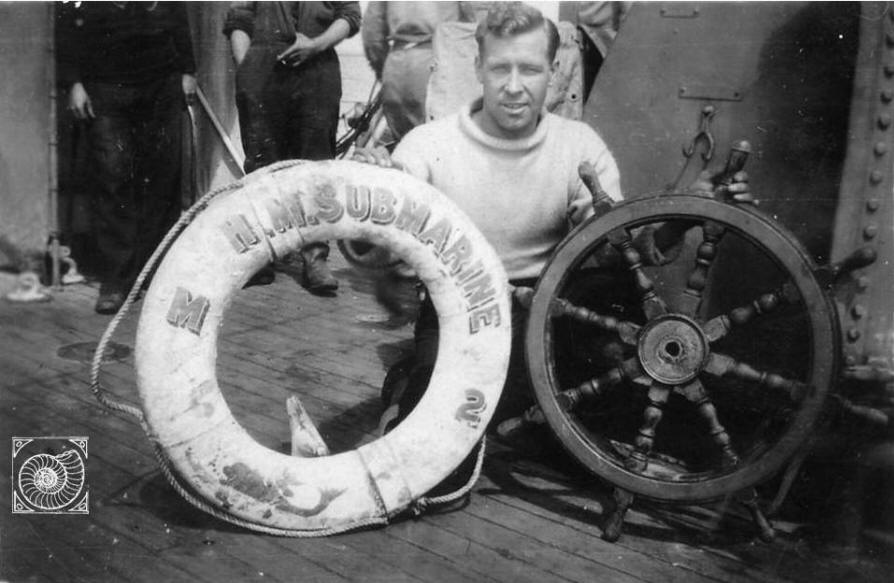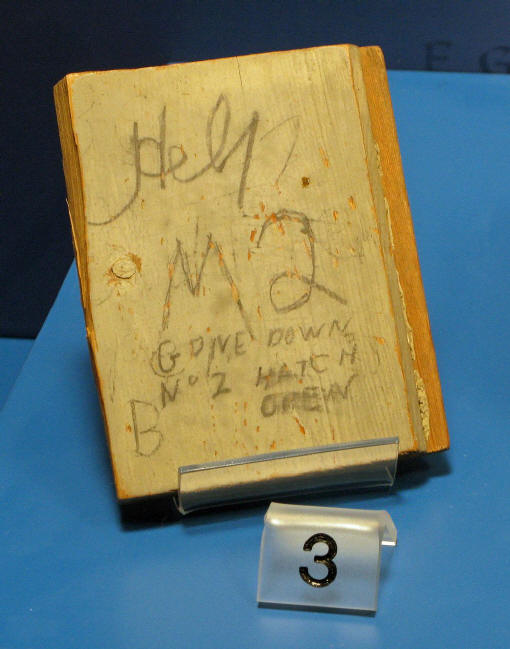
HMS M2. 1918 Submarine [31M] – Captain Lieut. Cdr. ‘RN’ Leathes. (Good detail in Dive Dorset: 102 p93 – 50 34.60N; 02 33.93W – Article, Simon Bird, Divers Guide; Weymouth & Portland, Ed. 4 page 300. (More detail in LARN) – West Bay. (Clarke: 50 34.60N; 02 34.01W with extra detail) War Grave. (Detail and photograph LePard pages 36 & 37). Portland Museum Wreck No. 15. Times References

Memorial to those that died

Items recovered from the M2
The M-2 sailed from Portland for a routine exercise at 9.00 a.m. and headed for a position 15 miles west of Portland Bill, where she was to link up with other submarines. Her CO. signalled HMS TITANIA that he intended to dive at 10.30 a.m. and this was to be the last communication with the submarine. Concern was shown at 16.15 p.m. when she failed to arrive back at Portland and search vessels were sent out. Since she carried DSEA apparatus for escape, there was hope that some of her crew might have survived, but none were found. Time was lost by divers working on what proved to an old wreck. News was received that Captain Howard of the Newcastle coaster TYNESIDER had sighted what was thought to be the M-2 between 11.15 & 11.30 on the day she disappeared. The report said they had seen a conning tower bearing the letter ‘M’ half a mile distant, after which she went down with her hanger doors open!!
Reference:
Beneath the Waves, A. S. Evans 1986. p179-184.
SRN: Vol. 1 p336-337.


Submarine Museum
Haslar, Gosport.
Item 3 – Help message from HMS M2.
This piece of wood was washed up on the Beach at Hallsands, Kingsbridge in 1932 after the M2 sank with all hands off Portland.
Written in pencil on one side is:
” Help M2 gone down No 2 hatch open”
on the other side is:
“HELP Lieut.”
Submarine M2
Times: Saturday, January 30, 1932, Issue 46044 – Loss of the M2: Editorial ‘All Hope Abandoned’ “There is no hope now for the men on board the submarine M2. After two and a half days – about sixty hours – of unbroken labours in which every available man and every known means have been unsparingly employed, the Admiralty were compelled yesterday to admit that in this strange duel the sea had won, that there was no hope of saving the lives of the sixty men whose homes are now desolate and whose brains, strength, courage, and devotion are lost to the country and the Service which mourn them. Somewhere-but where?-in the wreck-strewn deeps on the west of Portland Bill, “fast by their native shore”, their bodies lie imprisoned in what three days ago was a complex, sensitive marvel of man’s mastery over the elements, and is now but a useless, helpless trap for organisms that were far more marvelous than itself. The catastrophe is all the more crushing because it is so mysterious. The Poseidon, which sank last June, was rammed by a merchant ship. But the M2 knew no collision. “It was not in the battle. No tempest gave the shock” The ship dived in the ordinary course of her exercises; and in “the bay of a thousand “wrecks” she has disappeared as completely as if she had never been. The Admiralty, we may be sure, will not rest until the mystery has been explained, and it is known not only what unforeseen (and perhaps very trifling) cause turned so much young life and so much intricate power to naught, but also what the sea – the immemorial friend and irreconcilable foe of England-has done with the victim of her latest caprice. Meanwhile one more sum has been added to the price which England pays for admiralty; and the spirit of the whole nation will echo the deep sympathy which the King and Queen have sent to the bereaved families and to the officers and men of the submarines who have lost their brave comrades. Ship Incident
Times: More on the M2; Issue 46044 – Messages of Sympathy/ Search Continues. Ship Incident
Thursday, February 11, 1932, Issue 46054 – Salving of the M2 & The Lady Mayoress’s Fund. Ship Incident
Tuesday, March 22, 1932, Issue 46088 – M2: Salvage Operations (Page 8)
Thursday, September 22, 1932, Issue 46245 – More on the M2 Savage. “difficulties overcome by divers” Transcribe.
Tuesday, September 27, Issue 46249 – Very brief reference to salvage restarting. Ditto Issue 46260 Also Gales.
Times: September 21, 1932. From our Special Correspondent. Home News Submarine M2; Salvage Work Off Portland, Difficulties Overcome By Divers
“Today, in consequence of unfavourable easterly wind and a south-easterly swell, the ships engaged in the salvage of submarine M2 put into Portland Harbour. The work may be resumed tomorrow, but even a brief cessation of it is unfortunate. Preparations for raising the submarine have reached an important stage, and among those responsible for the operations one finds a spirit of hopefulness. The difficulties that have been encountered have probably been great that is generally realized. The spot where the submarine sank is not within the area of water where diving can be continuous; it is notorious for currents which at times make diving impossible. At spring tides the maximum current is estimated at three knots, and the conditions have limited operations directed immediately on the submarine to periods of slack water. But full advantage has been taken of the fine weather during the summer, and diving has been carried on day and night. The Tedworth, securely anchored by six moorings to resist storm and tides, continues to be the ship of action. There, immediately below the upper deck, is the diving flat. Alongside is a smaller auxiliary craft, which is also occasionally used for diving. It is moved to different points over the wreck and this permits direct action on any particular part of the submarine.
Work of the divers
The diving flat is the Tedworth is perhaps the most fascinating section of the salvage work. There, some 26 expert divers of the British Navy take their turn in entering 18 fathoms of water to reach the submarine. Carefully arranged on the floor of the flat are piles of diving equipment – the helmet with its telephone receiver, and the transmitter and telephone push with which the diver can signal by pressure of his tongue or cheek. The long line of air-pipe compreses many rolls, and there is the divers breast-pipe combined with a telephone cable. With its gauges, showing the depth at which the diver is working and the pressure of the water, this department is the nerve centre of the salvage operations.
Remarkable feats have been performed in the attempt to solve difficult problems involved in the raising of the M2. Outstanding features of the work of the divers have been the use of the oxy-hydrogen torch with which they have cut and removed parts of the submarine; their operations with pneumatic drills in piercing the hull, and their sealing of the sunken vessel to assist in giving her buoyancy. An important part of the final phase of the preparations has been the fixing of the submarine of pontoons, which will be filled with air. The increase of their number from two to four marks a change in the salvage plan. When the raising of the submarine was contemplated earlier in the year, two vessels were requisitioned equipped with steel ropes for lifting purposes. These have now been dispensed with, and instead of have two pontoons at the stern only, there will be two others at the bow. Three are already in position, and when the fourth has been placed and conditions are favourable, not much time will elapse before a definite attempt will be made to raise the submarine to the surface. The pontoons float horizontally immediately above the stern and bow of the submarine. Each has a lifting capacity of 80 tons, making in all 320 tons. Besides this lift, air will be pumped into the submarine by five air compressors to give bouyancy, and at the same time water will be forced out.
Article: Daily Mail Online: 2013
Royal Navy diver’s logbook offers fascinating insight into life on World War One submarine that sank when the door wasn’t closed properly. Forgotten diary of Albert ‘Bob’ Smale has been rediscovered by family
Details salvage operation to raise world’s first underwater aircraft carrier: Contact with HMS M2 was lost in January 1932 during routine exercise: All of the vessel’s 60-strong crew lost their lives in the tragedy: The logbook reveals it was a direct result of failure to secure the doors:
____________________
The forgotten logbook of a former Royal Navy diver has revealed fascinating details about a unique World War One submarine that sank over 80 years ago as the result of a simple failure to secure the door. The faded diary of Plymouth-born Albert ‘Bob’ Smale who, as a 23-year-old recently-qualified Navy Diver participated in a year-long salvage operation to raise the world’s very first underwater aircraft carrier, HMS M2, has been found by his family. Lee Smale, 62, of Plymouth, Devon, the youngest son of four children born to Bob and Gladys Smale remembers his father’s logbook from childhood.
The forgotten logbook of a former Royal Navy diver Bob Smale by his son Lee (pictured) has revealed a fascinating insight into attempts to raise a unique World War One submarine that sank over 80 years ago. The fading diary was rediscovered by the family of Plymouth-born Naval diver who participated in a year-long salvage operation to raise the world’s very first underwater aircraft carrier, HMS M2. ‘The logbook had always been in the family but it we’d never really given it much thought,’ he said. ‘He died in 1968 but it was only when we began sorting through my mother’s things when she moved into sheltered accommodation that it resurfaced. ‘But looking through all his belongings and coming across the logbook again the family recognised its significance.’
The M2 was one of four ‘M’ class submarines put into service during WW1 and following the cessation of hostilities was modified to carry a small two-seater Parnell Peto biplane. Intended for aerial reconnaissance during advance scouting missions, the aircraft had hinged wings to allow it to fit within a specially designed watertight hangar. Launched by hydraulic ‘catapult’ the Peto, on its return was recovered via a deck-mounted crane. On January 26, 1932 during a routine training exercise off West Bay, Dorset, after advising her support vessel of her intention to dive, all contact with the M2 was lost and the submarine disappeared without trace. A major search ensued but with her position unknown it was eight days before the M2’s location was eventually discovered. All of the vessel’s 60-strong crew lost their lives in the tragedy – believed to be a direct consequence of a failure to secure the submarine’s hangar doors before diving. Lying upright on the seabed at a depth in excess of 30 metres, the Royal Navy salvage team, hindered by the strong tidal currents that swirled around the M2, worked around the clock for 11 months to seal the hull prior to filling the vessel with air to refloat the stricken submarine. But as the salvage attempt reached its final stage, and only six metres from the surface, a heavy gale resulted in the operation being aborted and the M2 dropped back down to the seabed. The neat handwritten pages of the logbook initially record Mr. Smale’s diver training, but further examination revealed a passage dedicated to the M2 salvage work carried out by himself and his colleagues.
Under a heading entitled ‘M2 Salvage” Mr. Smale describes the ‘method of sealing hatches with cement.’ ‘Hatch is closed down and then a layer of small bags filled with cement is placed on top, and then a few buckets of loose cement is put on to fill in the spaces between bags.’ The logbook also contains a detailed hand-drawn illustration of the submarine showing its position, features and amendments prior to the failed lifting operation. The difficulties of working at such a depth, contending with strong tides, poor visibility and bad weather while dressed in the heavy brass helmets of the era are also conveyed in detail in a collection of newspaper cuttings pasted among the book’s pages.
The Dorset Daily Echo reported: ‘He has an electric torch swung around his neck. ‘The feeble illumination of this helps him when the torch is held close, but his principal asset is a sense of direction acquired by experience and that astonishing sensitiveness of touch which utter darkness gives to a diver as to a man who is blind.’ ‘My dad had quite a varied and distinguished career,’ continued Lee who also has a certificate in recognition of his father’s mention in dispatches during the Wanhsien Incident on the Yangtze River, China in 1926. Bob Smale was a contemporary and close friend of Lionel ‘Buster’ Crabb (pictured), the Royal Navy frogman who disappeared in mysterious circumstances at the height of the Cold War. Bob Smale was a contemporary and close friend of Lionel ‘Buster’ Crabb (pictured), the Royal Navy frogman who disappeared in mysterious circumstances at the height of the Cold War. Going on to achieve the rank of Petty Officer, Bob Smale was a contemporary and close friend of Lionel ‘Buster’ Crabb, the Royal Navy frogman who disappeared in mysterious circumstances at the height of the Cold War. Lieutenant Commander Crabb, came to prominence for his pioneering work in underwater bomb disposal during WW2 and while he had all but retired by 1955 just a year later he was recruited by M16 to investigate an advanced propulsion system used by the Soviet cruiser Ordzhonikidze during the vessel’s visit to the United Kingdom.
On the evening of April 19, 1956 Crabb descended into the murky waters of Portsmouth Harbour on what was to be his final mission and was never seen again. Several months later the headless and handless corpse of a diver was discovered floating in a nearby harbour, but this was not the end of Commander Crabb’s story. At the inquest into Crabb’s disappearance, the coroner’s report suggested that the body was in all probability that of the missing 47 year-old OBE and George Medal holder – despite to the lack of firm evidence which could have been provided by fingerprints or dental records. Unsurprisingly various theories abounded as to Crabb’s fate: he was killed by a Soviet sniper; eliminated by M15 or even defected to the USSR to head their military diving team. However, Lee Smale is adamant that his father’s friend didn’t die on that fateful night. ‘He and my father were apparently very close and he told members of the family at the time that he didn’t believe for one minute that Crabb was dead.’
With her protected status as a War Grave, the wreck of HMS M2 has now become popular dive site with recreational scuba divers. Allowed to dive her remains on a ‘look-but-don’t-touch’ basis, the modern day diver can observe the M2’s final resting place, just as Bob Smale did over eighty years ago.
Day of Loss: 26
Month of Loss: 1
Year of Loss: 1932
Longitude: 50 34.60
Latitude: 02 33.93
Approximate Depth: 31
